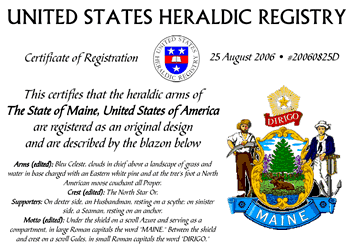U.S. Heraldic Registry
Registration of contemporary and historical American heraldry
The State of Maine, United States of America
Registration number 20060825D
This certifies that the heraldic arms of The State of Maine, United States of America are registered as an original design and are described by the blazon below

Sources
The historical note is quoted from FOTW Flags Of The World website at URL http://flagspot.net/flags/. Original author is Joe McMillan.
Image from "Kennebunkport, Maine." c1911. Taking the Long View: Panoramic Photographs, 1851-1991, Library of Congress.
Historical note
The coat of arms of Maine was adopted by a law of June 9, 1820, three months after Maine's admission to statehood. The law described the arms as "A Shield, argent, charged with a Pine Tree, a Moose-Deer, at the foot of it, recumbent. Supporters; on dexter side, an Husbandman, resting on a scythe; on sinister side, a Seaman, resting on an anchor. In the foreground, representing sea & land, & under the Shield, the name of the State, in large Roman capitals, to wit MAINE. The whole surmounted by a Crest, the North Star. The Motto, in small Roman capitals, in a label interposed between the Shield & Crest, viz. DIRIGO."
This language is quoted verbatim in the current law defining the state seal, Title 1, Maine Revised Statutes, Section 201. The arms were proposed by a committee chaired by state senate president William Moody. The concept of the design is credited to Benjamin Vaughn, the official description and explanation to Isaac G. Reed, and the original sketch of the design to Reed's stepdaughter Bertha Smouse. Reed's explanation of the design identifies the "moose-deer" as Cervus alces, a name now reserved for the European elk; the North American moose native to Maine and depicted on the current version of the arms is correctly Cervus canadensis. The moose symbolizes the unsettled lands of Maine as well as the spirit of independence and liberty.
The pine tree was described by Reed as "the staple of the commerce of Maine [and] the pride of her forests." He specifies the tree shown as a mast pine, and describes it as having five needles in each cluster. This identifies it as an Eastern white pine (Pinus strobus), which commonly grows to 30 meters (100 feet) and can reach 50 meters and more. On account of its size, the trees were prized for use in making ships' masts, hence the name "mast pine." Reed also cites the evergreen ("semper viridis") nature of the pine as reflecting the hopes of the citizens for the future of the state.
The crest, a single star, represents Maine as a state, alluding to the stars in the crest of the U.S. coat of arms a representing the collection of states. The North Star (Polaris, Alpha ursae minoris) is specified as appropriate for what was at the time the northernmost state. The motto, "Dirigo," which translates as "I direct" or "I guide" refers to the role of the North Star as the mariner's guide, implying a similar role for the state within the Union.
The supporters symbolize agriculture (dexter) and commerce and fisheries (sinister).
The website of the Maine secretary of state points out that there have been many variations in the way the emblem on the seal has been portrayed, but also notes that "all the variations [were] based on the language above." This includes the difference between Bertha Smouse's original sketch and the current rendition. On the other hand, it is worth pointing out that the current version of the arms, fixed by the legislature in 1919, does not conform to the blazon, in that the field of the shield is shown as a landscape with blue sky, not white (argent) as stipulated in the law. In addition, it would appear from the original sketch that the design committee intended the "sea & land" prescribed for the "foreground" to form a compartment upon which the farmer, sailor, and shield would stand, not to be shown on the shield itself. Given the ambiguous and un-heraldic phrasing, however, this variation is not surprising.
Registered by
Michael Swanson
